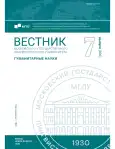The Сonceptual Internal form of a Hieroglyphic Sign as a Reflection of the Mindset of a Chinese Language Speaker (on the example of noun-zoonyms)
- Autores: Krasikova E.A.1, Mironenko K.N.2
-
Afiliações:
- Moscow State Linguistic University
- Military University named after Prince Alexander Nevsky of the Ministry of Defense of the Russian Federation
- Edição: Nº 7(901) (2025)
- Páginas: 68-74
- Seção: Linguistics
- URL: https://ogarev-online.ru/2542-2197/article/view/303321
- ID: 303321
Citar
Texto integral
Resumo
The purpose of this research is to analyze the inner form of words of the lexico-semantic group "animals" in the Chinese language. The research methods include lexico-semantic, cognitive and comparative analysis, on the basis of which the peculiarities of animal nomination are revealed through the prism of the Chinese linguistic worldview. As a result, the classification of the lexicosemantic group of nouns-zoonyms according to conceptual parameters is proposed: similarity in appearance, behavior, sounds, symbolic meaning, functions. The results indicate that Chinese ideographic writing reflects the ways in which native Chinese speakers categorizes reality.
Sobre autores
Elizaveta Krasikova
Moscow State Linguistic University
Autor responsável pela correspondência
Email: krasikova.liza@mail.ru
PhD (Philology), Associate Professor of the Department of Training Teachers of Rare Languages
RússiaKonstantin Mironenko
Military University named after Prince Alexander Nevsky of the Ministry of Defense of the Russian Federation
Email: mirkotofei@mail.ru
Adjunctat
RússiaBibliografia
- Krasikova, E. A. (2022). Linguocreativity in the formation of cultural codes: the experience of cognitive-discursive analysis of phraseological units and paroemias of the Russian and Chinese languages. In Slavic Phraseology and Paremiology. Cultural heritage and modernity (pp. 138–143): a collection of scientific articles. Gomel: Gomel State University named after Franzisk Skaryna. (In Russ.)
- Gorozhanov, A. I., Krasikova, E. A. (2024). Formal model for evaluating the image of a character in a fictional work (based on G. Orwell’s novel “1984”). Philology. Theory & Practice, 17(9), 3239–3248. (In Russ.)
- Radus, L. A., Mironenko, K. N. (2025). Image of the armed forces in the institutional and non-institutional media discourse of the PRC. Philology. Theory & Practice, 18 (2), 494–500. (In Russ.)
- Belyaevskaya, E. G. (2008). Component analysis VS conceptual analysis. Vestnik of Moscow State Linguistic University, 554, 140–146. (In Russ.)
- Belyaevskaya, E. G. (2013). Reflection of cognitive processes in the language semantics. Cognitive studies of language, 15, 276–287. (In Russ.)
- Taylor, J. R. (1989). Linguistic Categorization: Prototypes in Linguistic Theory. Oxford: Clarendon Press.
- Lakoff, G. (1987). Women, fire and dangerous things: What categories reveal about the mind. Chicago, London: The University of Chicago Press.
- 王寅 (2005). 认知语言学探索 重庆:重庆出版社。Wang Yin. Cognitive linguistics research. Chongqing: Chongqing Publishing House. (In Chinese)
- Boldyrev, N. N. (2012). Categorial system of language. Cognitive studies of language. In Categorization of the world in language (iss. X, pp. 17–101): a collective monograph. Moscow: Institute of Linguistics of the Russian Academy of Sciences; Tambov: Tambov State University named after G. R. Derzhavin. (In Russ.)
- Bondarchuk, G. G., Gorozhanov A. I. (2024). Representation of the category of clothing names in American linguoculture (corpus-based research). Humanities and law research, 11(4), 780–787. (In Russ.)
- Tan, Aoshuang (2004). The Chinese picture of the world: Language, culture, mentality. Moscow: Languages of Slavic Culture. (In Russ.)
- Zykova, I. V. (2017). Metalanguage of linguoculturology: constants and variants. Moscow: Gnosis. (In Russ.)
- Gotlib, O. M. (2007). Fundamentals of the grammatology of Chinese writing. Moscow: AST: East-West (In Russ.)
- Gorozhanov, A. I., Krasikova, E. A. (2024). Obtaining meaningful data from an unprepared text by automatically processing with author’s linguistic tools (based on the material of electronic Chinese media). Issues of Applied Linguistics, 54, 115–138. doi: 10.25076/vpl.54.05. (In Russ.)
- Gorozhanov, A. I. (2023). Building a linguistic corpus based on natural language processing tools: planning software solutions. Philology. Theory & Practice, 16(5), 1616–1620. doi: 10.30853/phil20230252. (In Russ.)
Arquivos suplementares










